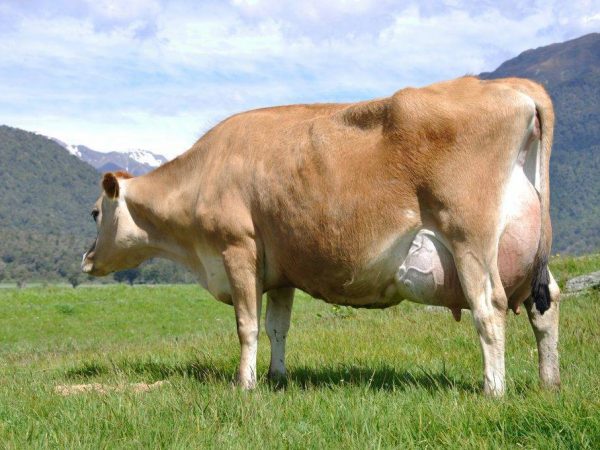Jersey breed of cows
Jersey cows are known for their economically profitable housing that brings good profits to farmers. Breeders achieve consistently high performance from representatives of this breed.

Jersey breed of cows
About the breed from the island of Jersey
Jersey cows, belonging to one of the oldest representatives of cattle, got their name from the Jersey island located in the Channel of the English Channel, which is located in the middle between France and England. Animals appeared as a result of crossing of local Norman and British representatives of cattle in order to improve their quality characteristics. In the process of breeding, inbreeding was actively used, therefore, in the new breed, specific features of an overdeveloped constitution and a dry physique began to be fixed.
Many are inclined to believe that cows from the island of Jersey are not adapted for the Russian climate, however, as the practice of domestic livestock breeding shows, animals of this type do not reduce productivity indicators when they are provided with a proper diet and appropriate conditions are maintained. Today Ryazan, Moscow, Novgorod and Leningrad farmers have this direction of cattle.
Originated as a result of crossing several breeds, this cattle began to develop further, thanks to the favorable natural conditions. Only by the end of the 18th century it was taken under control, and in 1866 it appeared in the list of the herd book. Six years later, the agricultural world society learned about the described variety of cows, and livestock began to appear on African, New Zealand and North American farms. Today, Jersey cattle are used most often to increase the fat and milk production of other varieties of cattle.
Exterior signs of the breed
The Jersey breed of cows belonging to the dairy direction is distinguished by its small size, which is noticeable in the photo and video. Characterization of the external exterior differences of animals from other cattle includes a description of its main features:
- a proportionally developed trunk of sufficient length with a characteristic angularity of the body, oblique ribs and a concave dorsal region, a narrow (up to 0.35-0.38 m) chest (up to 0.6 m),
- average height - 1.2 m,
- live weight of bulls - 0.6-0.75 tons, heifers - 0.4-0.45 tons,
- a small head with pronounced brow ridges and a narrow frontal part,
- slightly concave profile due to the shortly folded front part,
- thin neck covered with leathery folds,
- incorrectly set back with a raised tail,
- large cupped udder.
As a rule, the color of the Jersey cows is in shades of red, but can vary from light brown to dark. In some cases, the limbs or the lower part of the body are covered with white spots. Bulls differ from heifers in darker necks, limbs and heads.A dark stripe runs along the dorsal region.
Productivity indicators
The compactly built Jersey cow is capable of producing large quantities of dairy products with a pleasant smell and delicate taste. The fatty component of the Jersey cow's milk forms a thick cream on the surface.
By regularly monitoring the diet and properly caring for the Jersey breed of cows, you can expect from it up to 30-32 kg of milk with a fat content of up to 6-8% daily.
Average annual milk yields from Jersey cows vary within the range of 3.0-3.5 thousand tons liters. In some, figures were noted as high as 4000 liters. At the same time, the average fat content is within 5%.
The Jersey cow is bred not so much for meat production as solely for obtaining milk from her, therefore, these animals are not bred in order to obtain meat products. The slaughter yield of jersey cattle provides in small proportions, the meat characteristics of cattle are low.
Benefits and conditions for breeding
The Jersey breed showed good reproduction characteristics. Early maturing cows are able to start reproduction of calves when they reach the age of two, with uncomplicated calving that does not require intervention. Newborn calves weigh 20-22 kg, therefore they need careful care.
Feeding a calving cow should include compound feed, followed, three weeks after calving, by transferring it to her usual diet.
When the jersey calves reach the age of one week, they begin to introduce hay mixed with crushed chalk into their diet, and from the age of one month, vegetables (beets, potatoes) are included with a gradual increase in the amount and dilution of the milk given with water.
From the age of two months, many farmers begin to give the youngsters salt and red clay.
Reviews of private farms indicate that the Jersey breed of cows has many advantages that make this species attractive for breeding:
- high indicators of milk productivity bring rather big profit,
- the quality characteristic of milk includes a high content of fat, proteins and calcium, which makes the product competitive,
- a well-developed and proven reproductive feature allows you to get healthy offspring without complications during calving and in the absence of consequences after them,
- light weight and well-built limbs exclude the appearance of lameness and other ailments associated with the movement of animals.
Among the shortcomings, reviews note some signs of appearance, such as improper posture of the hind limbs. In addition, farmers would like to see more weight and bulk in Jersey cows in order to get more meat. Also, this cattle is characterized during keeping as restless in nature with a tendency to be frightened. The price for a Jersey breed of cows starts from 300 rubles. per 1 kg of weight.


